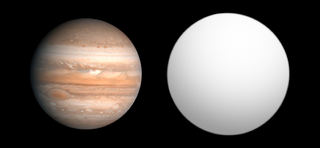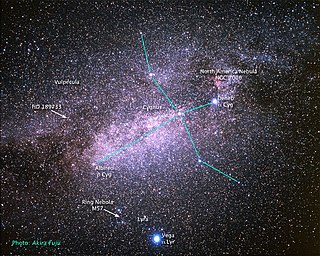Related Research Articles

TrES-1b is an extrasolar planet approximately 523 light-years away in the constellation of Lyra. The planet's mass and radius indicate that it is a Jovian planet with a similar bulk composition to Jupiter. Unlike Jupiter, but similar to many other planets detected around other stars, TrES-1 is located very close to its star, and belongs to the class of planets known as hot Jupiters. The planet was discovered orbiting around GSC 02652-01324.
HD 74156 is a yellow dwarf star in the constellation of Hydra, 210 light years from the Solar System. It is known to be orbited by two giant planets.
HD 150706 is a 7th magnitude star in the constellation of Ursa Minor. It is a remarkably Sun-like yellow dwarf being only 6% less massive than the Sun.

HD 189733, also catalogued as V452 Vulpeculae, is a binary star system approximately 64.5 light-years away in the constellation of Vulpecula. The primary star is suspected to be an orange dwarf star, while the secondary star is a red dwarf star. Given that this system has the same visual magnitude as HD 209458, it promises much for the study of close transiting extrasolar planets. The star can be found with binoculars 0.3 degrees east of the Dumbbell Nebula (M27).

Doppler spectroscopy is an indirect method for finding extrasolar planets and brown dwarfs from radial-velocity measurements via observation of Doppler shifts in the spectrum of the planet's parent star.

HD 154345 b, is a Jupiter-sized extrasolar planet orbiting the star HD 154345.
HD 154345 is a star in the northern constellation of Hercules. With an apparent visual magnitude of +6.76 it is a challenge to view with the naked eye, but using binoculars it is an easy target. The distance to this star is 59.7 light years based on parallax, but it is drifting closer with a radial velocity of −47 km/s. At least one exoplanet is orbiting this star.

HD 189733 b is an exoplanet approximately 64.5 light-years away from the Solar System in the constellation of Vulpecula. The planet was discovered orbiting the star HD 189733 on October 5, 2005, when astronomers in France observed the planet transiting across the face of the star. With a mass 16.2% higher than that of Jupiter and a radius 13.8% greater, HD 189733 b orbits its host star once every 2.2 days at an orbital speed of 152.5 kilometres per second (341,000 mph), making it a hot Jupiter with poor prospects for extraterrestrial life.
Being the closest transiting hot Jupiter to Earth, HD 189733 b is a subject for extensive atmospheric examination. The atmosphere of HD 189733b has been extensively studied through high- and low-resolution instruments, both from ground and space. HD 189733 b was the first extrasolar planet for which a thermal map was constructed, possibly to be detected through polarimetry, to have its overall color determined, to have a transit detected in X-ray spectrum, and to have carbon dioxide detected in its atmosphere.
HD 68988 is a star in the northern constellation of Ursa Major. It has been given the proper name Násti, which means star in the Northern Sami language. The name was selected in the NameExoWorlds campaign by Norway, during the 100th anniversary of the IAU. HD 68988 is too faint to be seen with the naked eye, having an apparent visual magnitude of 8.20. The star is located at a distance of 199 light years from the Sun based on parallax. It is drifting closer with a radial velocity of −69 km/s and is predicted to come as close as 78 light-years in 617,000 years.
HD 89307 is a star in the equatorial constellation of Leo. It is too faint to be viewed with the naked eye except under ideal conditions, having an apparent visual magnitude of 7.02. The star is located at a distance of 105 light years from the Sun based on parallax, and is drifting further away with a radial velocity of +23 km/s.
HD 24040 is a metal-rich G-type star located approximately 152 light-years away in the constellation of Taurus. In 2006 a long-period planet was discovered.
HIP 14810 c is an extrasolar planet approximately 165 light-years away in the constellation of Aries. This planet has mass at least 1.28 times that of Jupiter and orbits at 0.545 AU in an eccentric orbit. The planet was discovered by the N2K Consortium in 2006 and announced in a paper published in 2007. With the discovery of a third planet in the system which was announced in 2009, the parameters of this planet were revised.
HD 74156 c is an extrasolar planet at least eight times the mass of Jupiter orbiting the star HD 74156. It is most likely a gas giant. This planet was discovered by Dominique Naef and Michel Mayor in April 2001 together with the first planet HD 74156 b.
HD 74156 b is an extrasolar planet at least 1.88 times the mass of Jupiter that orbits the star HD 74156. It is most likely a gas giant. This planet was discovered in April 2001 by Dominique Naef and Michel Mayor along with the second planet HD 74156 c.
HD 187123 c is an extrasolar planet located approximately 156 light-years away in the constellation of Cygnus, orbiting the star HD 187123. This planet was published in 2006. The radius of the planet's orbit is 4.80 AU, 113 times more distant from the star than first companion. This takes 10 years to orbit. As it is typical for very long-period planets, the orbit is eccentric, referring to as "eccentric Jupiter". At periastron, the orbital distance is 3.60 AU and at apastron, the distance is 6.00 AU. The planet's mass is nearly 2 times that of Jupiter, but is likely to be smaller in size than the inner planet.
HD 183263 b is an extrasolar planet orbiting the star HD 183263. This planet has a minimum mass of 3.6 times more than Jupiter and takes 625 days to orbit the star. The planet was discovered on January 25, 2005 using multiple Doppler measurements of five nearby FGK main-sequence stars and subgiants obtained during the past 4–6 years at the Keck Observatory in Mauna Kea, Hawaii. These stars, namely, HD 183263, HD 117207, HD 188015, HD 45350, and HD 99492, all exhibit coherent variations in their Doppler shifts consistent with a planet in Keplerian motion, and the results were published in a paper by Geoffrey Marcy et al. Photometric observations were acquired for four of the five host stars with an automatic telescope at Fairborn Observatory. The lack of brightness variations in phase with the radial velocities supports planetary-reflex motion as the cause of the velocity variations. An additional planet in the system was discovered later.

HD 80606 b is an eccentric and hot Jupiter 190 light-years from the Sun in the constellation of Ursa Major. HD 80606 b was discovered orbiting the star HD 80606 in April 2001 by a team led by Michel Mayor and Didier Queloz. With a mass 4 times that of Jupiter, it is a gas giant. Because the planet transits the host star its radius can be determined using the transit method and was found to be slightly smaller than Jupiter's. Its density is slightly less than Earth's. It has an extremely eccentric orbit like a comet, with its orbit taking it very close to its star and then back out very far away from it every 111 days.
HD 183263 c is an exoplanet orbiting approximately 4.25 AU from the parent star HD 183263. This planet was announced by Wright et al. on December 8, 2008 using multiple observations in Lick and Keck Observatories earlier in that year. This planet was calculated to have minimum mass of 3.82 times more than Jupiter and takes 8.08 years to revolve around the star. The orbital distance varies from 3.17 to 5.33 AU, corresponding to the orbital eccentricity of 0.253.

An exoplanet is a planet located outside the Solar System. The first evidence of an exoplanet was noted as early as 1917, but was not recognized as such until 2016. No planet discovery has yet come from that evidence. However, the first scientific detection of an exoplanet began in 1988. Afterwards, the first confirmed detection came in 1992, with the discovery of several terrestrial-mass planets orbiting the pulsar PSR B1257+12. The first confirmation of an exoplanet orbiting a main-sequence star was made in 1995, when a giant planet was found in a four-day orbit around the nearby star 51 Pegasi. Some exoplanets have been imaged directly by telescopes, but the vast majority have been detected through indirect methods, such as the transit method and the radial-velocity method. As of 1 September 2021, there are 4,834 confirmed exoplanets in 3,572 planetary systems, with 795 systems having more than one planet. This is a list of the most notable discoveries.
References
- 1 2 3 4 5 6 7 Feng, Y. Katherina; et al. (2015). "The California Planet Survey IV: A Planet Orbiting the Giant Star HD 145934 and Updates to Seven Systems with Long-period Planets". The Astrophysical Journal. 800 (1). 22. arXiv: 1501.00633 . Bibcode:2015ApJ...800...22F. doi:10.1088/0004-637X/800/1/22.
- ↑ Wright, J. T.; et al. (2007). "Four New Exoplanets and Hints of Additional Substellar Companions to Exoplanet Host Stars". The Astrophysical Journal. 657 (1): 533–545. arXiv: astro-ph/0611658 . Bibcode:2007ApJ...657..533W. doi:10.1086/510553.
- ↑ Boisse, Isabelle; Pepe, Francesco; Perrier, Christian; Queloz, Didier; Bonfils, Xavier; Bouchy, François; Santos, Nuno C.; Arnold, Luc; Beuzit, Jean-Luc; Dìaz, Rodrigo F.; Delfosse, Xavier; Eggenberger, Anne; Ehrenreich, David; Forveille, Thierry; Hébrard, Guillaume; Lagrange, Anne-Marie; Lovis, Christophe; Mayor, Michel; Moutou, Claire; Naef, Dominique; Santerne, Alexandre; Ségransan, Damien; Sivan, Jean-Pierre; Udry, Stéphane (2012), "The SOPHIE search for northern extrasolar planets V. Follow-up of ELODIE candidates: Jupiter-analogs around Sun-like stars", Astronomy and Astrophysics, 545: A55, arXiv: 1205.5835 , Bibcode:2012A&A...545A..55B, doi:10.1051/0004-6361/201118419, S2CID 119109836